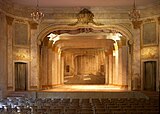Europavägen historiska teatrar
Europavägen historiska teatrar är en europeisk kultur- och temaväg som leder genom tio länder. Vägen sammanknyter betydande historiska teatrar från tidsperioden 1500-tal till 1800-tal.
Kulturvägen inrättades 2003 av den tyska ideella organisationen Perspectiv – Gesellschaft der historischen Theater Europas e.V. Den tyska beteckningen är Europastraße Historische Theater. Projektet stöds av EU. "Europavägen historiska teatrar" är uppdelat på fem delsträckor eller rutter: Norden-rutten, Tyskland-rutten, Engelska kanal-rutten, Italien-rutten och Kejsar-rutten. Kejsar-rutten öppnades i slutet av år 2011 och går genom Österrike och Tjeckien. Varje delsträcka innehåller mellan nio och tolv städer med lång teatertradition.
Den nordiska rutten sträcker sig genom Danmark, Norge och Sverige. Den svenska delen av Europavägen för historiska teatrar innehåller fem stationer: Drottningholms slottsteater, Ulriksdals slottsteater, Hedemora Gamla Theater, Gamla teatern i Vadstena och Ystads teater. I Danmark upptas Hofteatret på Christiansborgs slott och i Norge Fredrikshalds teater i Halden.
I Tyskland märks bland annat rokokoteatern i Neues Palais i Brandenburg (1769), Markgräfliches Opernhaus i Bayreuth (1748) och Ekhof-Theater i Gotha (1683). Engelska kanal-rutten innehåller bland annat Théâtre Royal du Parc i Bryssel (1782), Drury Lane Theatre (1663), Royal Opera House (1856) båda i London. Italien-rutten upptar bland annat Teatro Olimpico (1585) i Vicenza, Teatro all'Antica (1590) i Sabbioneta och Teatro Farnese (1618) i Parma.
Bilder, teatrar i urval
- Ulriksdals slottsteater, 2011
- Neues Palais, 2005
- Ekhofteatern, 2011
- Royal Opera House (Covent Garden Theatre), 1808
- Markgräfliches Opernhaus, 2006
- Teatro Olimpico, 2016
- Teatro Farnese, 2008
- Drury Lane Theatre, 1808
Källor
- Den här artikeln är helt eller delvis baserad på material från tyska Wikipedia.
- Europavägen för historiska teatrar, allmänt (tyska)
- Europavägen för historiska teatrar, nordiska rutten (svenska)
Externa länkar
 Wikimedia Commons har media som rör Europavägen historiska teatrar.
Wikimedia Commons har media som rör Europavägen historiska teatrar.- European Route of Historic Theatres
Media som används på denna webbplats
Författare/Upphovsman: Didier Descouens, Licens: CC BY-SA 4.0
Teatro Olimpico. Theater located in Vicenza, designed in 1580 by the architect of the Renaissance Andrea Palladio. It is generally considered the first permanent covered theater of modern times. View of the stage wall (Scaenae frons). Detail of the wooden decor of Vincenzo Scamozzi, visible through the openings of the stage wall.
Interior of Theatre Royal, Drury Lane. Circa 1808. Mistakenly ascribed to John Bluck by the website, but actually published as Plate 32 of Microcosm of London (1808) (see File:Microcosm of London Plate 009 - Billingsgate Market.jpg). The play is Coriolanuis, according to p. 43 of Sheridon Studies, Cambridge University Press (1995).
Författare/Upphovsman: Holger.Ellgaard, Licens: CC BY-SA 3.0
Ulriksdals slottsteater, scen
Covent-Garden Theatre: This engraving was published as Plate 27 of Microcosm of London (1808) (see File:Microcosm of London Plate 027 - Covent Garden Theatre.jpg).
Författare/Upphovsman: oxbox, Licens: CC BY-SA 3.0
Theater in New Palace, Potsdam, Germany
Författare/Upphovsman: www.bestofcinqueterre.com, Licens: CC BY-SA 4.0
This is a photo of a monument which is part of cultural heritage of Italy. This monument participates in the contest Wiki Loves Monuments Italia 2016. See authorisations.
Författare/Upphovsman: Stiftung Schloss Friedenstein Gotha, Licens: CC BY-SA 3.0
Stage of Ekhof-Theatre














